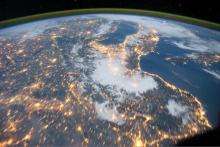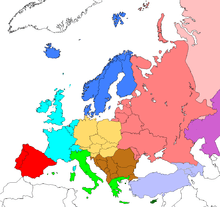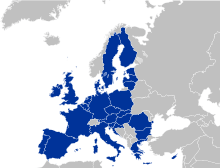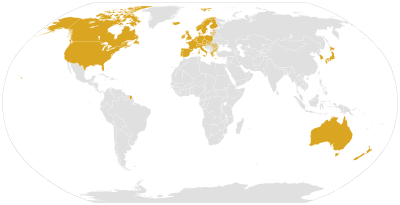Western Europe

Western Europe, also West Europe, is the region comprising the western part of the European continent. There may be differences between the geopolitical and purely geographic definitions of the term.
Historical divisions
Classical antiquity and medieval origins

Prior to the Roman conquest, a large part of Western Europe had adopted the newly developed La Tène culture. As the Roman domain expanded, a cultural and linguistic division appeared between the mainly Greek-speaking eastern provinces, which had formed the highly urbanized Hellenistic civilization, and the western territories, which in contrast largely adopted the Latin language. This cultural and linguistic division was eventually reinforced by the later political east-west division of the Roman Empire.
The division between these two was enhanced during Late Antiquity and the Middle Ages by a number of events. The Western Roman Empire collapsed, starting the Early Middle Ages. By contrast, the Eastern Roman Empire, mostly known as the Greek or Byzantine Empire, survived and even thrived for another 1000 years. The rise of the Frankish Empire in the west, and in particular the Great Schism between Eastern Orthodoxy and Roman Catholicism, enhanced the cultural and religious distinctiveness between Eastern and Western Europe.
After the conquest of the Byzantine Empire, center of the Eastern Orthodox Church, by the Muslim Ottoman Empire in the 15th century, and the gradual fragmentation of the Holy Roman Empire (which had replaced the Frankish Empire) the division between Roman Catholic and Protestant became more important in Europe than that with Eastern Orthodoxy.
Western Europe's significant historical events include the Renaissance, the Age of Discovery, the Protestant Reformation by Martin Luther and the Counter-Reformation of the Catholic Church, the Age of Enlightenment, the French Revolution and the Industrial Revolution.
In East Asia, Western Europe was historically known as taixi in China and taisei in Japan, which literally translates as the "Far West". The term Far West became synonymous with Western Europe in China during the Ming dynasty. The Italian Jesuit priest Matteo Ricci was one of the first writers in China to use the Far West as an Asian counterpart to the European concept of the Far East. In his writings, Ricci referred to himself as "Matteo of the Far West".[1] The term was still in use in the late 19th and early 20th centuries.
Cold War

During the final stages of World War II the future of Europe was decided between the Allies in the 1945 Yalta Conference, between the British Prime Minister, Winston Churchill, the U.S. President, Franklin D. Roosevelt, and the Premier of the Soviet Union, Joseph Stalin.
Post-war Europe would be divided into two major spheres: the West, influenced by the United States, and the Eastern Bloc, influenced by the Soviet Union. With the onset of the Cold War, Europe was divided by the Iron Curtain.
This term had been used during World War II by German Propaganda Minister Joseph Goebbels and later Count Lutz Schwerin von Krosigk in the last days of the war; however, its use was hugely popularised by Winston Churchill, who used it in his famous "Sinews of Peace" address on 5 March 1946 at Westminster College in Fulton, Missouri:
From Stettin in the Baltic to Trieste in the Adriatic an iron curtain has descended across the Continent. Behind that line lie all the capitals of the ancient states of Central and Eastern Europe. Warsaw, Berlin, Prague, Vienna, Budapest, Belgrade, Bucharest and Sofia; all these famous cities and the populations around them lie in what I must call the Soviet sphere, and all are subject, in one form or another, not only to Soviet influence but to a very high and in some cases increasing measure of control from Moscow.
Although some countries were officially neutral, they were classified according to the nature of their political and economic systems. This division largely defined the popular perception and understanding of Western Europe and its borders with Eastern Europe till this day.

The world changed dramatically with the fall of the Iron Curtain in 1989. The Federal Republic of Germany peacefully absorbed the German Democratic Republic, in German reunification. COMECON and the Warsaw Pact were dissolved, and in 1991, the Soviet Union ceased to exist. Several countries which had been part of the Soviet Union regained full independence.
Although the term Western Europe was more prominent during the Cold War, it remains much in use. The term commonly appears in the media and in everyday use, in "western" and other regions of Europe.
Western European Union
In 1948 the Treaty of Brussels was signed between Belgium, France, Luxembourg, the Netherlands and the United Kingdom. It was further revisited in 1954 at the Paris Conference, when the Western European Union was established. It was declared defunct in 2011, after the Treaty of Lisbon, and the Treaty of Brussels was terminated. When the Western European Union was dissolved, it had 10 member countries, six associate member countries, five observer countries and seven associate partner countries.
Modern divisions
United Nations Statistics Division geoscheme

The United Nations Statistics Division geoscheme is a scheme devised by the United Nations Statistics Division based on the M49 coding classification, which assigns countries to regions and subregions for statistical convenience.[2] These do not imply any assumption regarding political or other affiliation of countries or territories by the United Nations.[3] The geoscheme for Europe is divided into four groups: Eastern Europe, Northern Europe, Southern Europe and Western Europe. The Western Europe group consists of nine countries:
However, this geoscheme is not necessarily used in other agencies of the UN, including UNHCR[4]
CIA definitions

The CIA divides Western Europe into two smaller subregions.
The Western Europe group consists of eight countries:
The Southwestern group consists of three countries:
Western European and Others Group
The Western European and Others Group is one of several unofficial Regional Groups in the United Nations that act as voting blocs and negotiation forums. Regional voting blocs were formed in 1961 to encourage voting to various UN bodies from different regional groups.
European Union

The European Union (EU) is an economic and political union of 28 member states that are located primarily in Europe.[5][6]
EFTA
Some Western and Northern European countries of Iceland, Norway, Switzerland and Liechtenstein are members of EFTA, though cooperating to varying degree with the European Union.
Intermediate Region
The Intermediate Region is an established geopolitical model set forth in the 1970s by the Greek historian Dimitri Kitsikis. Under this model, the lands between the Adriatic Sea and the Indus River form the Intermediate Region, and are considered a bridge between Western and Eastern civilisations.
Other groupings and organisations
Other groupings and organisations covering the western part of Europe include:


 IMF developed economies
IMF developed economies
Population
Population of various countries that are commonly referred to as "Western Europe".[9]
| Country | Population (2011 est.) |
Population (2000 est.) |
-/+ of Population |
Percent change |
Capital | Population density (per km²) |
|---|---|---|---|---|---|---|
| 8,414,638 | 8,002,186 | 412,452 | 4.90% | Vienna | 101 | |
| 11,007,020 | 10,296,350 | 710,670 | 6.45% | Brussels | 366 | |
| |
5,564,219 | 5,330,020 | 234,019 | 4.20% | Copenhagen | 130 |
| |
5,388,417 | 5,167,486 | 220,931 | 4.10% | Helsinki | 17.9 |
| |
65,821,885 | 60,537,977 | 5,283,908 | 8.02% | Paris | 118 |
| |
81,799,600 | 82,163,475 | -363,875 | -0.44% | Berlin | 226 |
| |
10,815,197 | 10,964,020 | -148,823 | -0.88% | Athens | 82 |
| |
318,452 | 279,049 | 39,403 | 12.37% | Reykjavík | 3.20 |
| |
4,581,269 | 3,777,763 | 803,506 | 17.53% | Dublin | 65 |
| |
60,681,514 | 56,923,524 | 3,757,990 | 6.19% | Rome | 199 |
| |
511,840 | 433,600 | 78,240 | 15.28% | Luxembourg | 208 |
| |
16,699,600 | 15,863,950 | 835,650 | 5.00% | Amsterdam | 498 |
| 4,989,300 | 4,478,497 | 510,803 | 10.23% | Oslo | 15.6 | |
| |
10,647,763 | 10,195,014 | 452,749 | 4.25% | Lisbon | 115 |
| |
46,030,111 | 40,049,708 | 5,980,401 | 13.00% | Madrid | 93 |
| |
9,415,570 | 8,861,426 | 554,144 | 5.88% | Stockholm | 23.5 |
| |
7,866,500 | 7,162,444 | 704,056 | 8.95% | Bern | 196 |
| |
62,262,000 | 58,785,246 | 3,476,754 | 5.91% | London | 255 |
Climate
The climate of Western Europe varies from subtropical and desertic in the southern coast of Spain to polar in the Pyrenees. The Mediterranean climate of the south is dry and warm. The western and northwestern parts have a mild, generally humid climate, influenced by the North Atlantic Drift. In central and eastern Europe the climate is of the humid continental-type with warm summers.
Languages
Western European languages mostly fall within two Indo-European language groups: the Romance languages, derived from the Latin of the Roman Empire; and the Germanic languages, whose ancestor language came from southern Scandinavia.[10] Romance languages are spoken primarily in south-western Europe as well as in Central Europe. Germanic languages are spoken in Northern Europe, the British Isles and some parts of Central Europe.[10]
Several other smaller languages outside the two main groups exist in Western Europe. Other Indo-European languages include the Celtic group (that is, Irish, Scottish Gaelic, Manx, Welsh, Cornish, and Breton[10]). In addition, a distinct group of Uralic languages (Finnish and Hungarian) is spoken mainly in Finland, and Hungary. Maltese is the only Semitic language that is official within Western Europe, while Basque is the only Western European language isolate.
Multilingualism and the protection of regional and minority languages are recognised political goals in Western Europe today. The Council of Europe Framework Convention for the Protection of National Minorities and the Council of Europe's European Charter for Regional or Minority Languages set up a legal framework for language rights in Europe.
The following is a table displaying the number of speakers of the languages in Western Europe spoken by more than 5 million people:
Economy
Western Europe is one of the richest regions of the world. Germany has the highest GDP in Europe and the largest financial surplus of any country, Luxembourg has a highest GDP per capita, and France has the highest Net National Wealth of any European state.
Liechtenstein has the highest average wage of any state in Europe, Switzerland ranks highest in Europe on the Social Progress Index.
See also
Notes
- ↑ Both native and second language speakers residing in Europe only.
- ↑ Country is defined as being one of the 193 members of the United Nations. 'Recognised minority language' status is not included.
- ↑ Region is defined as being a subordinate constituent of a country, where a legitimate political entity has granted the language official status in that region.
References
- ↑ Ricci, Matteo (1610) [2009]. On Friendship: One Hundred Maxims for a Chinese Prince. Translated by Timothy Billings. Columbia University Press. pp. 19, 71, 87. ISBN 978-0231149242.
- ↑ "United Nations Statistics Division- Standard Country and Area Codes Classifications (M49)". un.org.
- ↑ United Nations Statistics Division- Standard Country and Area Codes Classifications (M49)
- ↑ United Nations High Commissioner for Refugees. "UNHCR - Northern, Western, Central and Southern Europe". unhcr.org.
- ↑ "Basic information on the European Union". European Union. europa.eu. Retrieved 4 October 2012.
- ↑ "European". Oxford English Dictionary. Retrieved 3 October 2011.
5 b. spec. Designating a developing series of economic and political unions between certain countries of Europe from 1952 onwards, as European Economic Community, European Community, European Union
- ↑ http://www.scs.illinois.edu/~mcdonald/WorldHaplogroupsMaps.pdf
- ↑ "European Y-DNA haplogroups frequencies by country". Eupedia.
- ↑ "EUROPE, GEOGRAPHICAL AND POLITICAL – National Geographic Style Manual". Stylemanual.ngs.org. 1 November 1993. Retrieved 19 July 2012.
- 1 2 3 "Europe". Encyclopædia Britannica. 2007. Retrieved 10 June 2008.
- ↑ Catalan News Agency - Number of Catalan speakers rising despite adverse context
- ↑ Informe sobre la Situació de la Llengua Catalana | Xarxa CRUSCAT. Coneixements, usos i representacions del català
- ↑ Croatian at Ethnologue (18th ed., 2015)
- ↑ Czech at Ethnologue (18th ed., 2015)
- ↑ Danish at Ethnologue (18th ed., 2015)
- ↑ Dutch at Ethnologue (18th ed., 2015)
- ↑ English at Ethnologue (18th ed., 2015)
- ↑ Finnish at Ethnologue (18th ed., 2015)
- ↑ French at Ethnologue (18th ed., 2015)
- ↑ Le Statut spécial de la Vallée d'Aoste, Article 38, Title VI. Region Vallée d'Aoste. Archived from the original on 4 November 2011. Retrieved 2 May 2014.
- ↑ http://www.regione.taa.it/normativa/statuto_speciale.pdf
- ↑ Greek at Ethnologue (18th ed., 2015)
- ↑ Hungarian at Ethnologue (18th ed., 2015)
- ↑ Italian at Ethnologue (18th ed., 2015)
- ↑ Polish at Ethnologue (18th ed., 2015)
- ↑ Portuguese at Ethnologue (18th ed., 2015)
- ↑ Slovak at Ethnologue (18th ed., 2015)
- ↑ Spanish at Ethnologue (18th ed., 2015)
- ↑ Swedish at Ethnologue (18th ed., 2015)
Sources
- The Making of Europe, ISBN 0-14-015409-4, by Robert Bartlett
- Crescent and Cross, ISBN 1-84212-753-5, by Hugh Bicheno
- The Normans, ISBN 0-7524-2881-0, by Trevor Rowley
- 1066: The Year of the Three Battles, ISBN 0-7126-6672-9, by Frank McLynn
External links
| Wikimedia Commons has media related to: |